How To Manage Ecommerce Returns Like a Pro This Christmas
A flexible, customer-centric ecommerce returns process will help you win trust, drive sales and increase customer satisfaction this holiday season. In this article, our Content Manager Hannah explores eight ways you can create a winning returns strategy that would get Scrooge himself smiling.
Written By
Hannah Smiddy

Returns: the bane of any ecommerce business. And this is a headache that only gets harsher in the holiday season, with close to 30% of online purchases being returned!
Your ecommerce returns process can make or break your business, especially over the festive period when unwanted gifts start flooding back. Get it right, and 95% of shoppers will buy from you again. Get it wrong, however, and you’re 3x more likely to lose a customer for good.
Today, we’re walking through our eight top tops for creating a winning holiday returns strategy for your ecommerce business. You can use the way you handle festive returns to your advantage, showcasing your commitment to first-class customer service and differentiating your brand as a top player amongst competitors – all-in-all winning trust, driving sales and nurturing loyalty.
Ready? Let’s get started.
#1 Extend your standard ecommerce returns window for Christmas
As a start, we’d recommend extending your holiday returns window beyond the standard timeframe you have in place already. Often, companies will extend this through to the end of January. Much-loved British retail chain John Lewis has done exactly this:
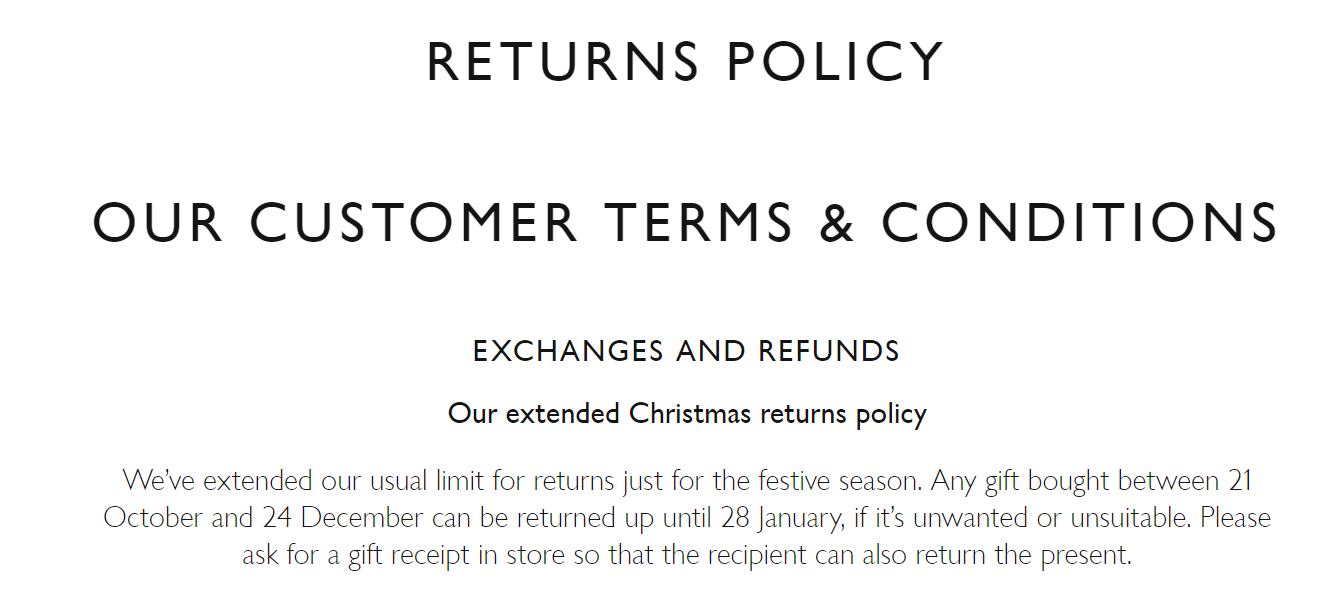
First off, this will help to drive holiday sales. An extended returns window provides gift-givers with peace of mind when doing their Christmas shopping online – especially those super-organised shoppers who are buying gifts in advance of December. Customers want to be able to shop with confidence, knowing that if they buy a gift during November, the recipient will be able to return it after the 25th of December without any problems.
Extending your ecommerce returns window also impacts the customer experience for gift recipients. By providing people with plenty of time to receive their gifts and then organise a return if necessary, you can increase overall customer satisfaction and persuade shoppers to come back to your store long after the holidays are over.
#2 Consider offering free returns for the holiday season
How many times have you been shopping online, only to discover the brand doesn’t offer free returns? Chances are you swiftly exited their store in search of a better, more convenient policy.
Indeed, 90% of consumers ‘highly value’ free returns and 69% are actually deterred from buying online if they have to pay for return shipping. With this in mind, offering free returns is a great tactic to convert browsers into buyers over the yuletide season.
Plus, taking the expense out of your returns can go a long way toward securing a tribe of loyal customers who’ll keep coming back for more, long after the Christmas decorations have come down.
Of course, each individual business will need to do some number-crunching to examine the financial impact of offering free returns for the holidays. If the cost of return shipping is too much for your business, get creative.
Consider only offering free returns on orders over £50, for instance. This ensures you won’t absorb large shipping costs on low-value items. It could also encourage customers to add a few extra items to their Christmas cart just to reach your free returns threshold, bumping up average order value (AOV) nicely!
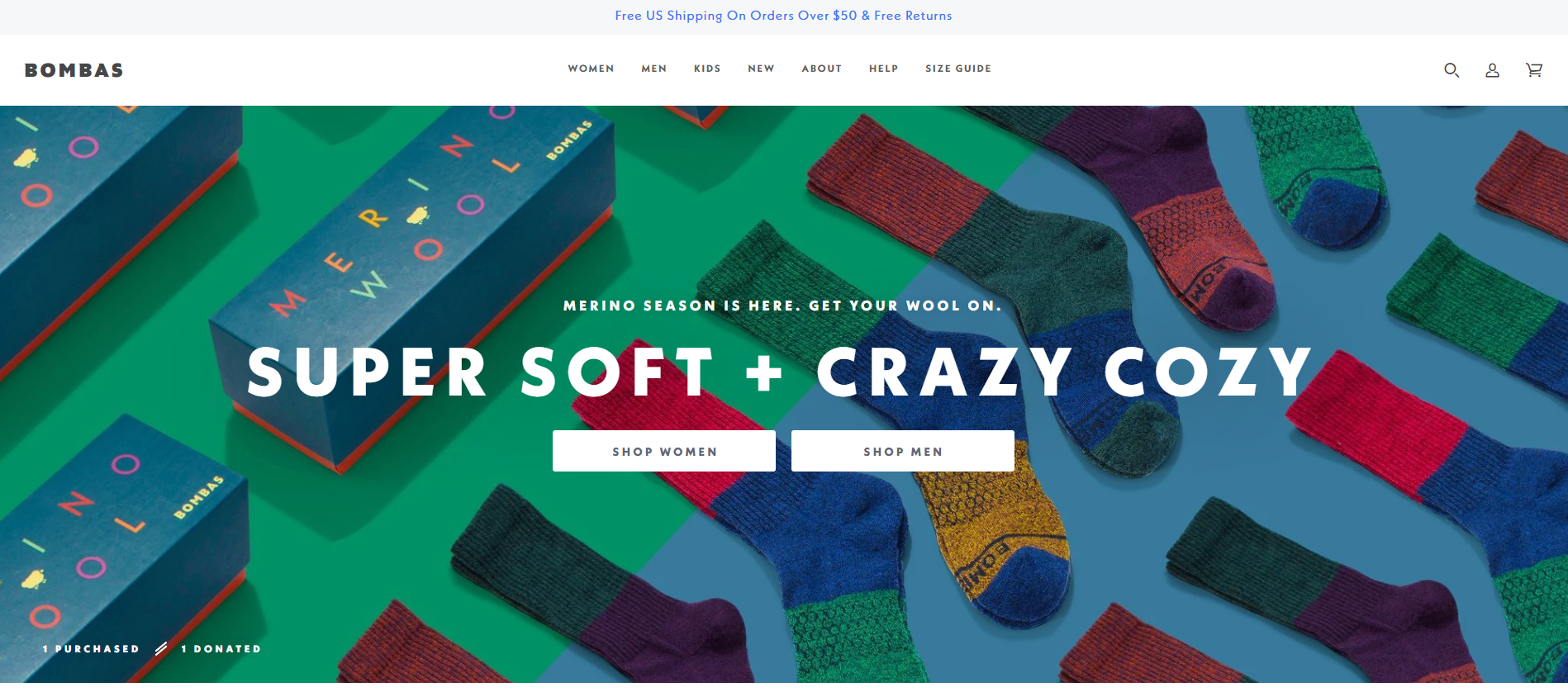
Premium sock retailer (and Shopify Plus success story!) Bombas offers free returns on orders over $50, which is a clever strategy to boost AOV.
#3 Create a clear and concise ecommerce returns policy
Make sure your ecommerce returns policy is easy to understand. Don’t frustrate customers with reams of text that takes ages to get to the point. And don’t stuff your policy with endless legal jargon either – customer’s don’t want to have to decode a complicated statement!
Clearly and concisely explain what the return window is, whether customers will receive a full refund or store credit, and who is responsible for shipping costs. These are the main points that concern customers, so transparency is key. By clearly setting out guidelines for returns, you’re giving consumers clear expectations.
If you’re updating your policy for the holiday season as we recommended above, then make sure you communicate this. Clearly state what your Christmas returns window is, along with all the different options for making returns.
Use a conversational, friendly tone to reinforce peace of mind. Weave your brand voice into your policy to reinforce your identity and continue building a consistent shopping experience. This will help your customers to feel comfortable with your ecommerce returns process, increasing the likelihood of them coming back for more.
Shopify offers its merchants use of a free return policy generator to create a professional, ready-to-use policy. Check it out here.
#4 Illustrate the ecommerce returns process on your site
When faced with a wall of dense small print, customers will zone out. With this in mind, it’s time to get those creative juices flowing!
Apply a UX mindset and use graphics, icons, images and video (all on-brand, of course) to explain your returns process in a nutshell. Don’t forget to give your illustration a sprinkling of festive magic with some seasonal imagery.
At a quick glance, customers should be able to understand exactly what a return entails. This will increase shoppers’ confidence in your brand and ease any concerns they have about a possible return.
Visually representing the steps of your returns process is also a good chance to develop a human connection with your customers. Creating a fun and consumable returns interaction will set you apart from your competitors and encourage shoppers to associate your brand with a positive experience.
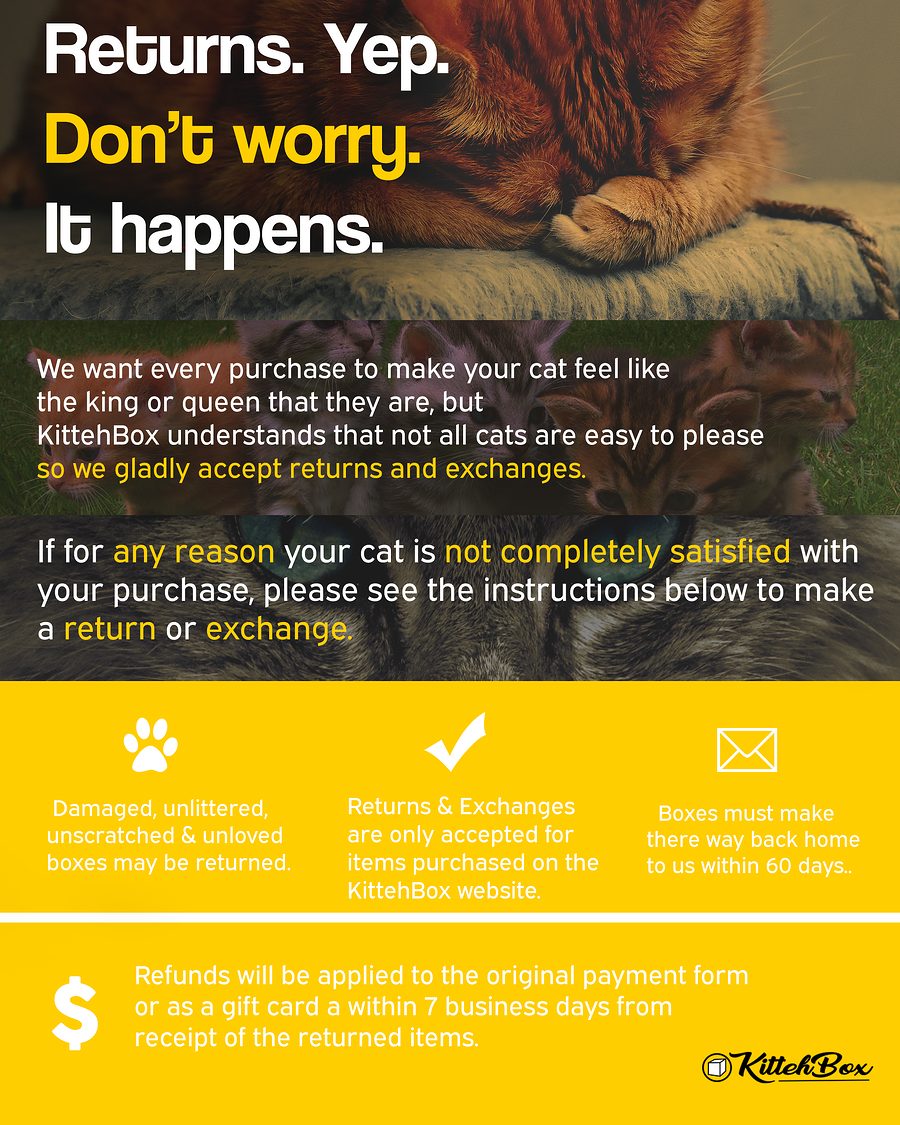
KittehBox has crafted a unique infographic to depict their returns policy. It clearly provides all the necessary information to customers in a fun and humorous way, whilst conveying a strong sense of brand identity. (Source: ReturnLogic)
#5 Make your holiday returns policy easy to find
So, you’ve extended your holiday returns window and written a clear and concise policy with some awesome graphics – great. Now you need to make sure that it’s easy to find on your store. After all, 63% of online shoppers check a refund policy before purchasing.
Create a smooth shopping experience for these customers by making your returns policy easily accessible from various points across your site. Don’t make them play detective!
Key places to link to your policy include your website footer and FAQ page. It’s especially important that customers can access returns details from the pages where they are making purchasing decisions as well, so consider adding a link to your policy on your product pages and in the cart.

Shopify Plus-powered fashion brand and Swanky client Cefinn provide returns info in clear view on their product pages.
You should also highlight your returns process in any post-purchase emails, as well as in physical format in your packaging.
Making your policy easy to find will help create trust amongst your consumers, as it demonstrates that you are thinking long-term. It shows you care about the policy and have a clear process in place to facilitate returns, which is key for reassuring shoppers that they won’t be stuck with an item they’re not happy with. In turn, this can lead to increased sales!
#6 Create a branded self-service returns portal
If you don’t already provide your customers with a self-service returns portal, then the holiday season is the perfect time to transform your ecommerce returns process!
Offering a self-service portal streamlines the returns process for both you and your customers, and ensures a consistent, hassle-free experience for users. Customers can easily initiate a return and create a label in just a few clicks, without having to contact a customer service rep.
Simplifying the returns process like this is a surefire way to encourage repeat purchases and boost customer loyalty – did you know that 72% of consumers say they would spend more and buy more often from a brand that makes the returns experience simple?
Leading ecommerce fulfilment solution ShipStation takes this self-service option to the next level, allowing merchants to create a branded portal. By infusing your brand identity into the returns process, you can create a much more consistent post-purchase experience, thereby increasing trust and confidence amongst your customers.
This handy video explains how easy it is for customers to create return labels using ShipStation’s branded portal:
This seamless returns experience is something shoppers will remember next time they’re looking to buy online. In fact, ShipStation found that customers were 28.8% more likely to order from the same merchant again after returning an item through a self-service portal.
This type of returns process has an extra advantage: merchants can use the portal to easily capture and collate reasons for returns. Over time, this will provide valuable actionable insights into your products and fulfilment process. For instance, if your items are frequently returned because of damage during shipping, you might want to review the packaging you’re using. Or, if several items are being returned faulty, this might indicate an issue with the product manufacturer that needs resolving.
#7 Include a returns label in your packaging
Another way to simplify the returns process and keep your Christmas customers satisfied is to provide a pre-printed returns label packaged with each order. This is a super-simple way to please a customer and ease the burden of making a return.
If all a customer has to do is stick the label on the original box or bag their order came in and take it to a drop-off point, they’ll feel much more comfortable making a purchase with you. Convenience is everything, after all. You’re minimising the amount of effort needed by your customer, making your brand’s shopping experience a lot more appealing.
As well as providing convenience, ready-made returns labels can help to protect you from fraudulent returns. Some people might try to take advantage of your free returns process by claiming that everything they bought is in the return package when it isn’t. But, by providing a label, you can include SKUs, invoice numbers and quantities, for example, so that your team know exactly what should be included with the return when it arrives back for processing.
A downside to this strategy that you might want to consider is that you’ll end up printing lots of labels that remain unused, which can be rather costly and not very friendly to the environment.
#8 Provide different returns options
Consider offering a range of returns options across a number of channels in order to provide ultimate convenience for your customers over the holiday season. Don’t add to the January blues by restricting returns to just one option. Customers will appreciate the flexibility of multiple returns options, and are far more likely to shop with you again because of this customer-centric experience.
If you run a brick-and-mortar shop alongside your ecommerce store, allow shoppers to return items that they bought online to your physical store. 62% of consumers prefer returning online purchases to offline stores if such an option is available, so don’t miss this opportunity to keep your customers satisfied.
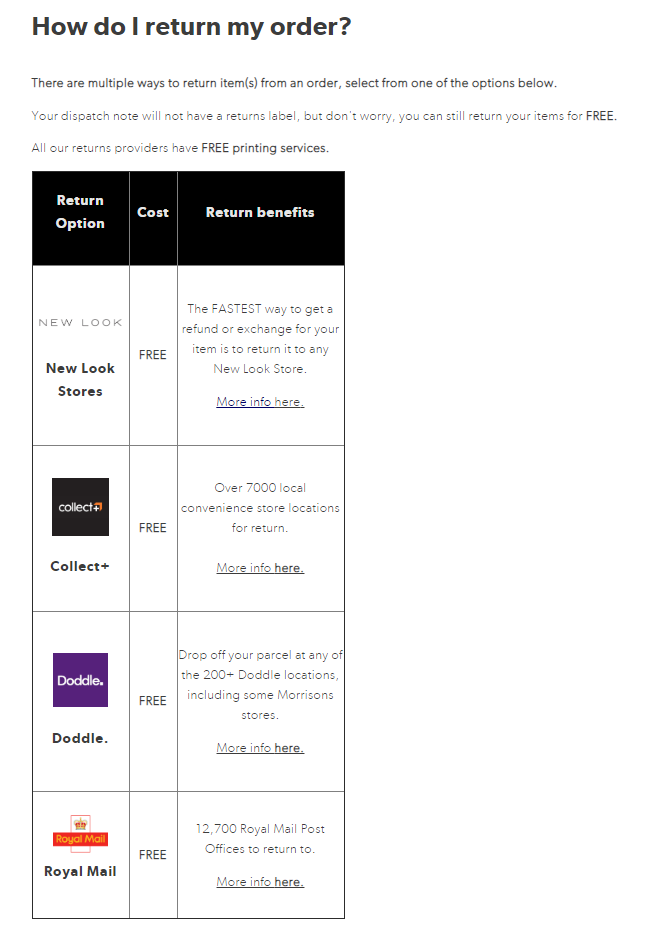
Omnichannel fashion retailer New Look offers customers four free options for returning online purchases, including taking the item/s back to any brick-and-mortar New Look store.
Having online customers visit your retail space presents a valuable opportunity to engage customers with a first-class in-store experience and promote your products in a more immersive way. You could end up converting a return into an exchange or even up-selling additional items – perfect for boosting your beginning-of-the year sales!
If you’re not an omnichannel retailer, fear not. Ecommerce-only merchants can still provide multichannel returns options using services like CollectPlus or Doddle. Customers can simply take unwanted items to their local participating store at a time convenient for them, where it will be returned to the retailer. Huge ecommerce players such as ASOS, Skinnydip and Gymshark currently work with CollectPlus and Doddle, taking the hassle out of returns for their online customers.
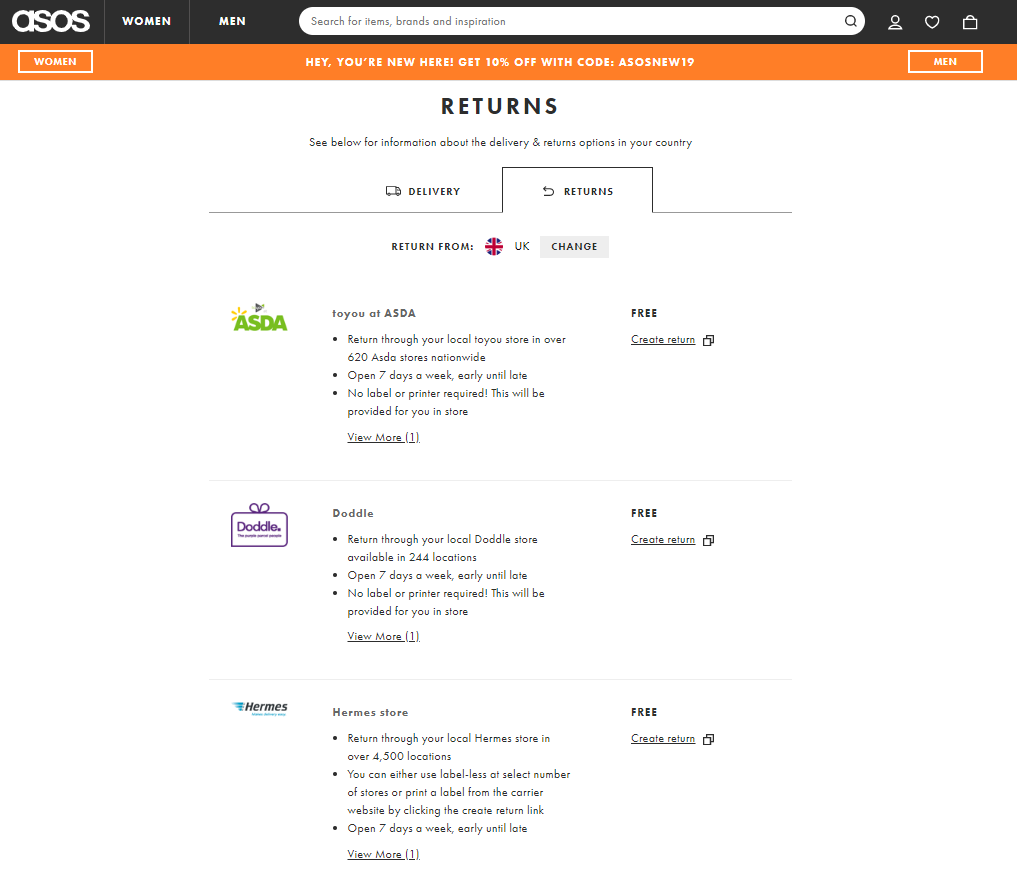
These are just a few of the in-store returns options offered by online fashion retailer ASOS. Customers can select the most convenient option for them, creating a hassle-free ecommerce returns process without any shipping fees.
Shipping and returns solution – Swanky’s recommendation
For all your ecommerce fulfilment needs, we recommend shipping solution ShipStation.  Designed to save merchants time and money, this intuitive platform lets you import, manage and ship orders across unlimited selling channels. Create pick lists, print shipping labels and manage returns, all in a single platform.
Designed to save merchants time and money, this intuitive platform lets you import, manage and ship orders across unlimited selling channels. Create pick lists, print shipping labels and manage returns, all in a single platform.
To find out more about ShipStation and how it can increase efficiency for ecommerce merchants, check out our recent Q&A session with Kevin Kline and Mike Hayers.
And for more Christmas shipping tips, check out this guest blog post from ShipStation’s James Messer, where you’ll find expert advice on how to avoid the biggest shipping mistakes over the holiday season.
A winning ecommerce returns process – a summary
The ideal holiday ecommerce returns process has the customer experience at its core. Make things as easy as possible for consumers, offering clarity, convenience and flexibility at every stage of the process.
Drive sales by building trust and reassuring customers that should they need to return an item, it’s a hassle-free process. And when it comes to the actual return, encourage repeat purchases by providing a streamlined, on-brand experience with a range of multichannel options for customers to pick from.
You can take these holiday tips and translate them into an ecommerce returns strategy that ‘sleighs’ all year around, long after the tinsel is taken down and the garlands are gathered up.
Give us a call!
If you’re looking for an experienced Shopify agency to help take your ecommerce brand to the next level, look no further than Swanky. We are passionate about helping enterprise merchants navigate the competitive world of ecommerce with our expert guidance and data-driven growth strategies.
Reach out to our team today to find out more!

